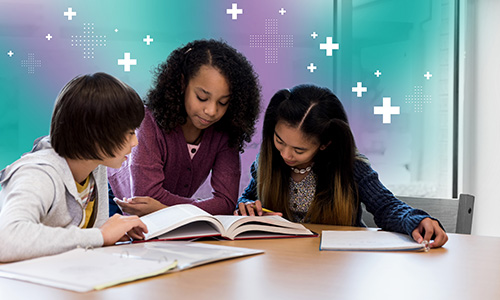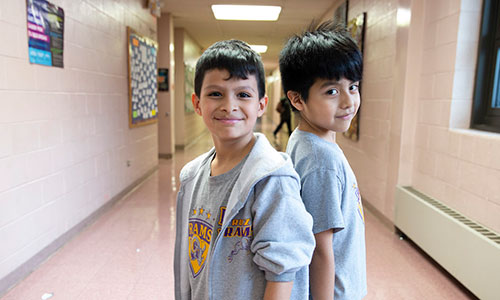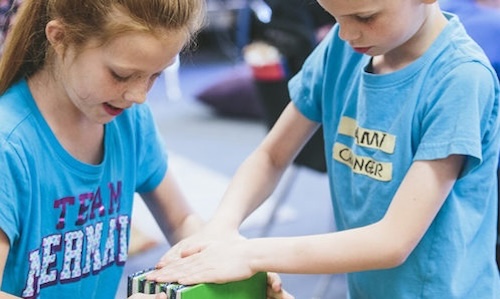
Digital literacy is something we didn’t have to think much about a few decades ago. But as the amount of information available to us—from online newspapers and other websites to social media videos and more—seems to multiply daily, it’s increasingly important for educators to help students gain digital literacy.
The American Library Association defines digital literacy as “the ability to use information and communication technologies to find, evaluate, create, and communicate information, requiring both cognitive and technical skills.” That’s a long definition, and it describes something that can feel easier said than done.
We can all be fooled
I’ve run across the following quotation countless times: “Isn’t it funny how day by day nothing changes but when you look back, everything is different?” It can be found all over the Internet, with multiple sources attributing it to C. S. Lewis’s Chronicles of Narnia series. With so many different sources saying Lewis wrote the words, how would we know that, in fact, he didn’t?
The sentiment expressed in this quotation exemplifies what has happened to digital literacy. We can look back just 30 years and observe that the digital landscape was very different then from what we see now. Over time, relatively unnoticeable changes have added up to huge differences in how we gather information and interact with others.
The confusion around the quotation’s origins drives home the point that we must be savvy consumers of information we consume in the new digital world. Students and teachers are having to learn to access more information presented in new ways, for example, multimodal texts that incorporate not only print but also images or sounds. They are also needing to sort through that information to separate the truth from misinformation by reading critically and corroborating sources. Then they must share their learnings responsibly.
Times have changed
Let’s think for a moment about how information is presented now versus in the past.
Traditionally, back in the “old days,” as my kids say, if we wanted to learn something about a specific topic, we needed to read an article about it or (gasp!) use the card catalog at the library to find a book on the topic, which we then pored over for hours. We also learned from newspapers printed on paper, magazines printed on paper, or newscasts in the evening, which were available only a few times a day. Some reading this may remember how Walter Cronkite, whom we trusted to keep us informed about events of the world, would sign off: “And that’s the way it is.” Well, that’s the way it was.
Compare all those activities to now. If we want to learn about a specific topic, we can access online articles by searching for keywords, looking over the list of titles that pops up, and then skimming a selected article to quickly see if it fulfills our quest for information. That digital article will likely look different from articles we used to see in print. It may have audio or visual elements embedded or hyperlinks to other digital texts that can take us further down the rabbit hole as we search for the answers we seek. Or we can watch a video on YouTube or TikTok, or maybe even listen to a podcast. What’s likely is we will do all those things. After all, there are now about 200 million active websites vying for our attention.
Misinformation abounds
As we spend time poking around some of those millions of websites, what do we do if we run across information that conflicts? What if the person producing the text, audio, or video is only a self-proclaimed expert? How can we tell? Those questions also apply to the information we are getting on newscasts. How do we determine if the news media is reporting in an unbiased manner? How can we learn to fact-check on our own rather than relying on fact-check sites that may have their own biases or perspectives? These are problems confronting society, and schools are now having to help students navigate this space to be fully informed digital citizens of the world.
Unfortunately, the digital world has changed so fast that the K–12 educational system hasn’t had much time to think and plan for how to help students best avail themselves of digital information and how to then use it responsibly to inform others. In fact, the term “digital literacy” is still being defined by some. In 2020, a group of researchers spent some time analyzing how people were thinking of digital literacy, and after reading over 20,000 articles on the subject, their conclusion was that there are two ways to think about it: “skills-competencies for the use of technology” and “teaching-learning and its strategies.” Both are important.
How to support today’s kids
Students should be taught how to use technology, from how to use a keyboard to how to write an email. They should also be taught how to maximize technology to increase their knowledge. That is, they should be taught how to know if a source is reliable and how to check for accuracy of information.
What, then, can educators do to facilitate student learning in this space? I have three recommendations.
1. Start small
When teaching your students digital literacy, begin by helping them identify key words. Having the right key words can enable them to find information closest to what they are looking for. It’s also important to help students learn to interact with different formats. Practicing with different sources of information can help them get in the habit of questioning everything they encounter.
Something to try: To practice with key words, find an informational public domain article on a topic of interest to your students. Print it out and black out the title and any subtitles, as those often include key words students will end up selecting. Make enough copies for all your students. Then, create a list of questions related to the topic of the article.
Put your students in small groups and have them work to brainstorm the key words they think they would need to use to find answers to your questions quickly. Once students have a list of keywords they want to try, set a timer and let them loose to see who can identify the best key words the fastest. Discuss as a class both the successful searches and those less successful, and why particular words worked and others didn’t.
To give kids practice working with information in different formats, find a text that presents information differently from a textbook. It might be a digital article with hyperlinks, like this blog post. Or it might be an interactive map that allows students to click the graphics to learn more. It could even be a video or podcast. Work with students to explore the information and its various features, discussing how the format differs from the forms they encounter most often at school. How do they need to adjust to effectively glean the important information?
You can also serve as a model for effective use of digital formats, consistently presenting information during lessons and using multimodal or nonstandard texts, surveys to increase class participation, digital white boards, and more.
2. Make meaningful connections
To help students make meaningful connections, I encourage you to focus on building background and helping them analyze sources.
Some things to try for building background: For younger students, have them read an informational text that is part of your current unit of study. Tell them they will be digital investigators and need to learn at least three more details about the topic. Provide them with at least three student-friendly, topic-related websites they can use to build their knowledge while becoming more digitally literate. Teach them about the search bar and the other features on the sites that can help guide them to helpful information.
Sites you might consider, depending on the topic of study, include the National Park Service website for students, NASA website for students, and National Geographic Kids website.
This same concept can be used with older students as well, even with literary texts. For example, students who understand the historical context surrounding Passing by Nella Larsen have a much better chance of understanding the various themes. Have them explore what was happening in America during the 1920s, including racial tensions, The Great Migration, and classism. Discuss how those events are revealed throughout the book.
Some things to try for analyzing sources: Many older students are well acquainted with social media platforms, and just as many may not realize how much misinformation is posted there. If you have a bit of extra time right before the end of class, show students something that has gone viral and have them discuss it. Ask questions, such as, how could we determine if this information is true or if this event really happened? Could there be another side to this story? What words does the social media post use that may give us a hint about how the creator feels about the topic? Could their perspective be masking the truth?
The News Literacy Project is a wonderful organization you can use to learn more about ways to teach students to discern fact from fiction on the web. Learn more about these free materials and resources in my article “Helping students get to the truth with the News Literacy Project.”
3. Integrate practices into other content areas
Often, when people hear the word “literacy,” they immediately think of language arts. But as my colleague Miah Daughtery explains in “How not to teach literacy across disciplines,” literacy—including digital literacy—is an important part of all content areas.
Something to try: If you’re an ELA teacher and feel tasked with teaching digital literacy all by yourself, reach out to colleagues. Maybe even consider starting a PLC dedicated to brainstorming ways for incorporating digital literacy into all content areas.
Math teachers could show kids how the Pythagorean theorem is used in the real world. In social studies, your colleagues could bring history to life with videos of people recreating historical events, timelines, and primary source materials housed in libraries and available digitally worldwide. Science teachers can explain the role of blood in our bodies by showing moving diagrams of blood flow, or they can assign a podcast where scientists explain chemical reactions and the results of various experiments.
Change is constant
“Isn’t it funny how day by day nothing changes but when you look back, everything is different?” Everything is different now because of changes in technology.
Many of us are still working to improve our own digital literacy. Seize that as a great opportunity to remember how it feels to be a learner, immersed in knowledge acquisition. Get in the trenches with your students. It’s okay that we, too, are wading through vast amounts of digital information, presented in interesting formats, with each needing to be vetted for accuracy and potential bias. It’s a challenge for both educators and students, but one day we will look back and realize this was an exciting time of exploration in education that helped create more savvy world citizens.







